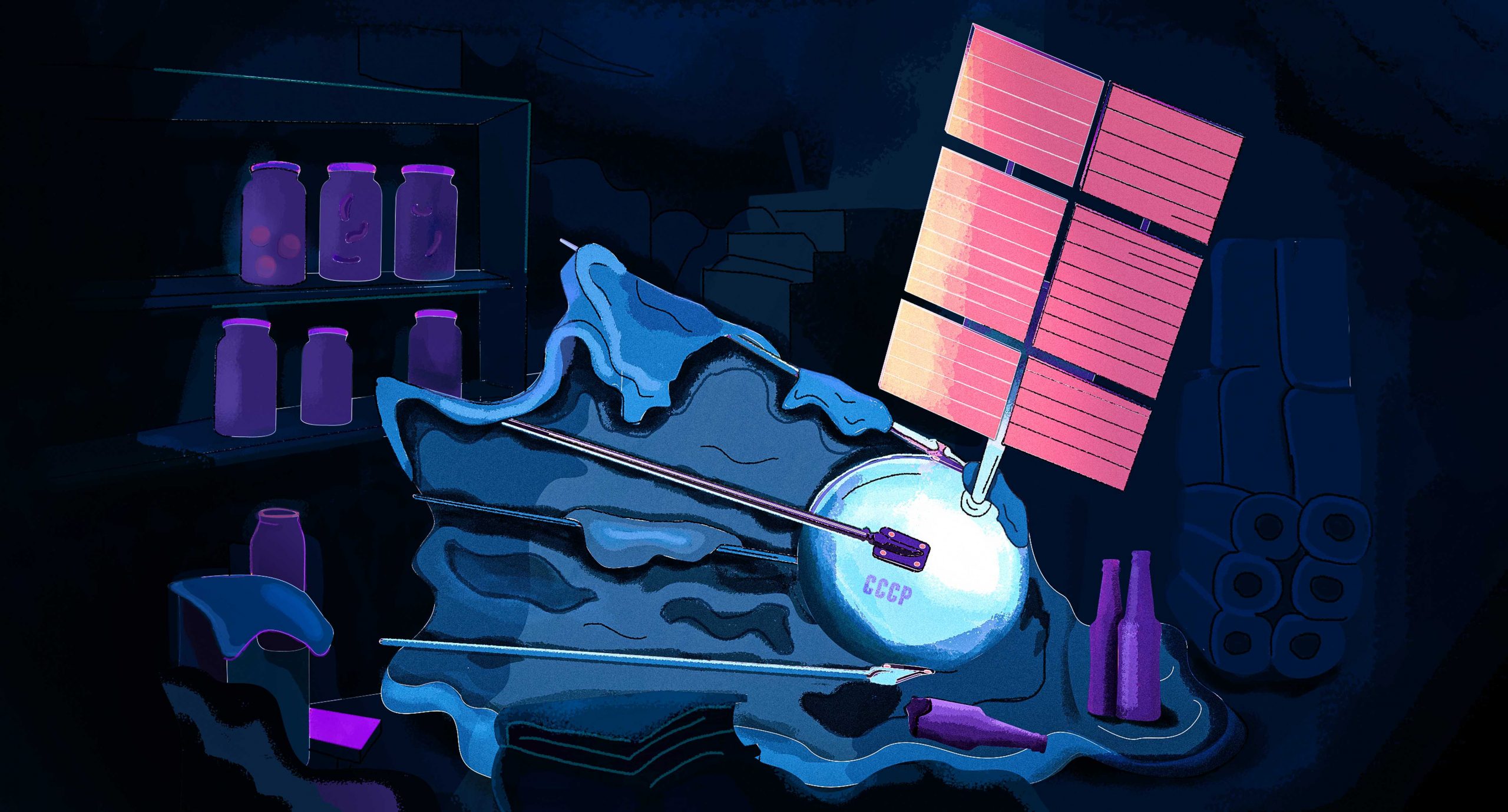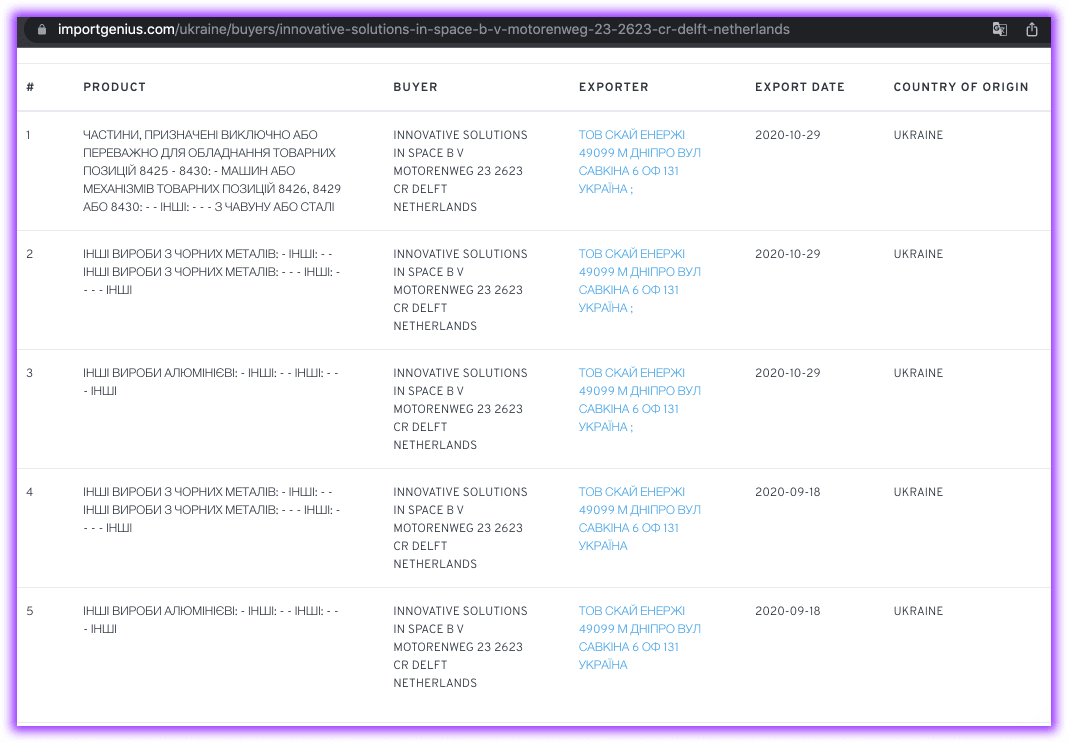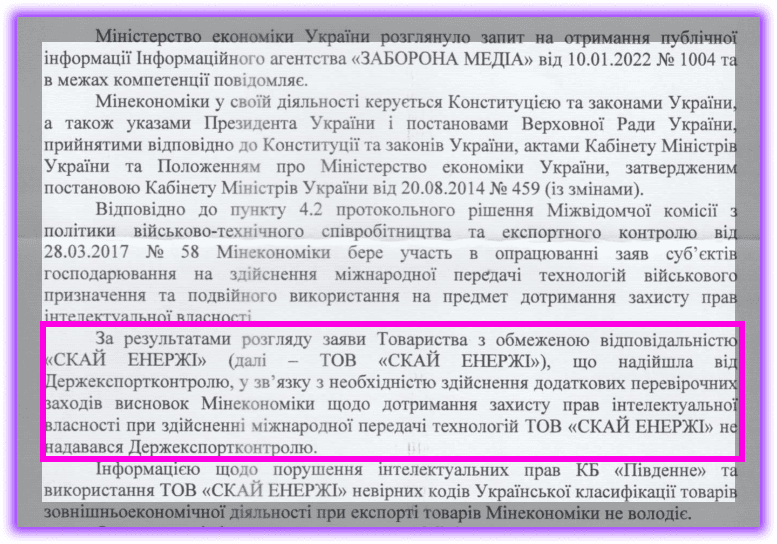On January 13, 2022, an important event in the history of the Ukrainian space industry took place. For the first time in more than 10 years, Ukraine launched its own satellite into orbit. A great number of Ukrainian officials, opinion leaders and media perceived this event as a huge achievement. However, Zaborona’s investigative journalist Oleksandr Humeniuk managed to find out that the launch of the Sich-2-30 satellite was carried out with serious violations. Moreover, some facts point to corruption behind the scenes.
Why was Sich-2-30 launched into space?
A few months ago Zaborona noted that Sich-2-30 was not a new satellite, but rather a copy of the Sich-2 spacecraft which was launched into orbit by Ukraine 11 years ago. The purpose of the copy’s creation was to work out emergency situations that can happen in orbit. The original satellite managed to work for only six months and eventually turned into space debris, despite initial assurances that it would be able to work for five years. As a result, Sich-2’s copy was sent to the warehouses of Pivdenne State Design Office in Dnipro. This copy was later called the Sich-2-30 satellite and was presented as a new breakthrough of the Ukrainian space industry, despite the fact that the spacecraft was considered obsolete more than 10 years ago and merits its own place in a museum.

Liliia Hebryn
As it turned out, it’s all about resolution. Spatial resolution is one of the crucial features of such spacecraft. This term implies the coverage area of the Earth’s surface, which is photographed by a satellite, and which will be fixed in one pixel of the image. The higher the resolution, the more detailed and better the image is obtained, Liliia Hebryn, Ph.D. in Technical Science and associate professor of the Department of Aerospace Geodesy and Land Management of the National Aviation University explained to Zaborona. The resolution of the Sich-2-30 satellite is approximately 7.8 meters. And it is truly sad, because modern satellites of such type are able to transmit an image with a resolution of 30 centimeters– 26 times better than the Ukrainian one.
The launch of the satellite is shrouded in corruption
The story of the Sich-2-30 satellite launch started during the period when the State Space Agency was chaired by Mykhailo Lev. Another person who promoted this launch was Dmytro Natalukha, the chairman of the Verkhovna Rada of Ukraine Committee on Economic Development.

Dmytro Natalukha. Photo: Kuzmin Oleksandr / UNIAN
“In March 2020, we came to Dnipro for a special committee meeting, and one of the main topics was the revival of the Ukrainian space industry. Dehtyarev (the former CEO of Pivdenne State Design Office) provided us with a little tour. It was very funny because we were walking around in there: through the first hangar, second hangar, third hangar… And then he says: ‘Oh, and here is the Sich satellite’. When we entered, we caught sight of a massive device slightly covered with an oilcloth. We asked why it was there and not in space. He explained that there was no political will. So we said: ‘Okay, what is the readiness of the craft?’ and Dehtyarev replied that it was between 80-85 per cent,” Dmytro Natalukha tells Zaborona.

Mykhailo Lev. Photo: European Business Association / Facebook
The former chairman of the State Space Agency, Mykhailo Lev, also recalls that visit well.
“Pivdenne Design Office spent 110 million hryvnias ($3,9 million) of its own funds to create this satellite. When I asked why this craft stayed in a warehouse and not in orbit, they replied that the launch would cost between 6 to 8 million dollars, and they didn’t have the funds. It was also necessary to finalize the ground segment, which costs around 30-40 million hryvnias, plus another 20 million hryvnias to finish the satellite,” Mykhailo Lev says in an interview with Zaborona.
Realizing that a satellite launch by Chinese or Indian partners could cost $6-8 million, Mykhailo Lev wrote a letter to American company SpaceX owned by Elon Musk.
“I wrote to SpaceX personally. They have an accessible direct form of communication on the website,” says Mykhailo Lev. “Regarding the launch, we communicated with their specialist who is responsible for the satellite launch program and payload on Falcons [Medium-lift launch vehicles, created by Elon Musk’s company]. He said that the weight of 160 kilograms would cost us roughly $1 million. Well, one million dollars is much less than six, and, of course, I was interested in their offer, because the longer this satellite lies in the warehouse of Pivdenne Design Office, the more it becomes obsolete. Due to the fact that over one hundred million hryvnias had already been spent, I understood that if we launched it and spent another $1 million, we might return to orbit,” Mykhailo Lev tells Zaborona.
Mykhailo Lev was truly interested in the prospect of launching a Ukrainian satellite into space with SpaceX’s cooperation. Firstly, it cost several times less than the offers of other partners with whom Ukraine used to work. Secondly, the launch of even an obsoleted satellite could become a symbol of the resurrection of the Ukrainian space industry. Thirdly, several million dollars had already been spent on this satellite, and there were only two options left: either admit that all of the money had been wasted, or spend a few millions more and launch the satellite into space.

Oleh Uruskiy. Photo: Kovalchuk Viktor / UNIAN
The former chairman of Ukraine’s State Space Agency decided to look for funding for this project — and the money was found. As Mykhailo Lev explains, it was taken from other unpromising projects. Then he handed over the order on the redistribution of funds for approval to Oleh Uruskiy, the former Minister for Strategic Industries of Ukraine and the former chairman of the State Space Agency (2015)
“There was a meeting between the chairman of the Committee on Economics (Dmytro Natalukha) with his deputy and Mr. Uruskiy. The Minister said that the satellite was unable to launch, and they had different orbits with SpaceX. The project was unrealistic,” says Mykhailo Lev. “They told him: look, the chairman of the Space Agency said that it was possible, so let’s try! As our negotiations with SpaceX progressed, Uruskiy realized that absolutely everything was real. He met with President Zelensky and said: “Volodymyr Oleksandrovych, we are going to launch a satellite,” and started promoting himself everywhere he was able to. But, at the same time, he launched a narrative that there was a Space Agency and Mykhailo Lev was going to block everything and disrupt our satellite launch.”
An advance payment for SpaceX
SpaceX set only one condition for Ukraine — to make an advance payment. This was supposed to make it possible to book a place on the launch vehicle and guaranteed the American company that said place would not remain empty.
“At the end of February 2021, [Mykhailo Lev] already had a preliminary agreement on his table,” recalls Dmytro Natalukha, the chairman of the Verkhovna Rada’s Committee on Economic Development. “Moreover, it was a direct contract without any intermediaries for the launch and for the booking place on the launch vehicle for Sich-2-30 satellite. The price was $1 million. So, the only condition that SpaceX put forward was to make an advance payment by the end of April.”
Mykhailo Lev and Dmytro Natalukha made a few attempts to solve problems and make sure that Pivdenne Design Office would be able to redistribute and spend funds for an advance payment. However, it was not possible to carry it out on time. After that, SpaceX informed Ukraine that they could not guarantee the launch of the satellite in December, arguing that the advance payment had not been made in due time.

Illustration: Artem Markov / Zaborona
Afterwards, Mykhailo Lev was forced to resign from the State Space Agency, and Dmytro Natalukha, the chairman of the Ukrainian parliament’s Committee on Economics publicly stated that he would no longer participate in the project.
“I handed over the contract with SpaceX and all our contacts with them to Mr. Uruskiy at the Committee meeting. t I relieved myself of all responsibility,” says Dmytro Natalukha. “At that time, Mykhailo Lev had already been sacked, and then the whole story continued without us. We became observers.”
Intermediaries and obscure adapters
After Mykhailo Lev’s resignation, Oleh Uruskiy, the new Space Agency management and the Minister for Strategic Industries of Ukraine, found an intermediary — the Dutch company ISILAUNCH, which also cooperates with SpaceX. This intermediary guaranteed the Ukrainian side a place for a satellite on the launch vehicle, but on one condition: the cost of the satellite launch was set at $1 million with direct cooperation. However, with the intermediary, according to Mykhailo Lev, the price almost doubled to $1.8 million.
“They [the Dutch] argued their motivation for increasing the price by the fact that they were going to provide their adapter, because with our adapter SpaceX was unable to accommodate the satellite. Notwithstanding, when we were in the negotiation process with SpaceX, there were no difficulties. Even more, they offered to certify our adapter,” recalls Mykhailo Lev.
This means that SpaceX had been completely satisfied with the Ukrainian spacecraft adapter manufactured at Pivdenne State Design Office. However, when the Dutch intermediary took the stage, everything changed — the manufacture of the adapter and the money for its manufacture was entrusted to the Dutch company. According to information confirmed to Zaborona by several sources, ISILAUNCH then hired a Ukrainian private company SKY ENERGY LLC as a subcontractor, which allegedly have been assigned to produce special plates for attaching the satellite to the launch vehicle. This company is located in Dnipro and its connection with Pivdenne State Design Office is manifested not only by general location: its chairman and owner is Yuriy Prokopenko, a former employee of Pivdenne. He worked there for about 20 years.
According to information provided by Mykhailo Lev, the majority of employees at SKY ENERGY are former workers of Pivdenne Design Office. Moreover, this company doesn’t have the manufacturing capacity to assemble such adapters. The same information was confirmed to Zaborona by sources from within the enterprise who expressed the desire to remain anonymous.
“In my opinion, this is the same adapter that was in the Pivdenne Design Office’s warehouse from the very beginning,” says the former chairman of Ukraine’s State Space Agency.
To find out what kind of adapter was installed on the satellite and whether it was really an adapter manufactured at Pivdenne’s facilities, despite money having been paid to the SKY ENERGY LLC, we turned to Pivdenne Design Office for a comment. Among other questions, we asked them one in particular. However, the Bureau did not respond to any of them, arguing that it was a trade secret. Neither Pivdenne Design Office nor the State Space Agency could tell us what kind of private company it was, what capacities were used for manufacturing the adapter and why its services were needed at all, due to the fact that Pivdenne has its own adapters of the same type.
“According to information provided to me by sources from the Export Control Service, these adapters and fasteners were manufactured by Pivdenne Design Office,” says Dmytro Natalukha. “And, respectively, they were exported via a private company, which allegedly sourced (the process of transferring part of the task to a third-party contractor on subcontract terms) the production of these adapters.”
A Ukrainian scheme: Exporting space technologies
The problems did not end there. Another gray area in the story of the Ukrainian satellite launch is hidden in the private Ukraine company’s export details of spare parts for the adapter to the Netherlands. According to the information provided by ImportGenius, SKY ENERGY LLC had previously supplied similar products to the Dutch company. But, as it turned out, it did not indicate in the documents that exported goods were space technology, and marked them instead as metal products.

Data from the ImportGenius website
According to Zaborona sources, it seems that SKY ENERGY LLC had some difficulties with exporting devices for the launch of the Sich-2-30 satellite. As reported by a few media outlets and Zaborona’s sources, the Export Control Service of Ukraine had suspended the export of products for the launch of the Sich-2-30 satellite for some time.
“This is an absolutely clear legal procedure, thanks to which the Export Control Service may check these companies before giving permission to export military or special-use goods (which, in principle, include space technologies),” notes Mykhailo Lev. “When the appropriate political will appears and law enforcement agencies will be able to investigate all these things impartially, then they will have enough information to answer what these companies were doing all that time.”
However, the temporary suspension in the space goods exporting process was short-lived. Subsequently, the Ukrainian Export Service gave permission for their export from Ukraine either due to pressure from above, or for some other reasons.
To find out whether there really was an inspection and what results it brought, Zaborona sent a request to the Ministry of Economy of Ukraine, which adjusts the activity of the State Export Control Service. In response, they reported that they had indeed received an application from the Export Control Service, which concerned SKY ENERGY LLC. However, due to the fact that the situation required additional investigation, the Ministry did not provide its conclusion to the Export Service. Furthermore, they have no information about the violation of the intellectual rights of Pivdenne Design Office, nor the improper use of product classification codes by SKY ENERGY LLC.

Response of the Ministry of Economy of Ukraine to the Zaborona’s request
In other words, the Ministry of Economy admits that the State Export Control Service had certain complaints against SKY ENERGY LLC, which, apparently, were separate from the Ministry of Economy.. In our view, this is a bit odd, considering that the company is fully accountable to the Ministry.
What’s wrong with the satellite now?
At the beginning of our investigation, we mentioned that this satellite is a copy of the Sich-2 spacecraft, which was launched into space 11 years ago. It had been working for only six months before it turned into space trash. And it looks like we are now able to update that record. A few weeks have passed since the launch of the Sich-2-30 satellite, and we have yet to see any pictures taken by it, which the leaders of the space industry and the state could use to their benefit in their speeches. For now, we have all the reasons to believe that the satellite was lost immediately after the launch.
Recently, space expert Andrii Kolesnyk published a post on Facebook. According to him, the Ukrainian satellite Sich-2-30 has not yet been identified. The author of the post suggested that there was no connection at all with the Sich-2-30 satellite. That is why it was impossible to provide information to the American side about the extended parameters of its movement for complete identification.
This information was also confirmed to Zaborona by sources related to the space industry. According to them, there is still no stable connection with the satellite. Despite that, there are a few other problems that prevent the satellite from starting the normal performance of its initial options. We also received information that a special commission has already been established at the government level with the task of finding out who is to blame for this. As Zaborona sources inform us, there are no details yet, but the President of Ukraine Volodymyr Zelensky is aware of the situation and is strongly dissatisfied, because the failure of the launch creates a lot of trouble for him personally.
When this information became public, more and more new questions began to appear, and eventually the management of Pivdenne Design Office realized that silence was not an option. On January 27, a message about the status of the satellite was released on the official Facebook page of the company.
“A number of external factors related to the peculiarities of the cluster launch did not allow us to establish a stable connection with the spacecraft during the critical first sessions and ensure the timely configuration of its standard orientation,” said the message by Pivdenne. “The spacecraft froze in orientation when only solar radiation reflected from the Earth’s surface or short-term direct radiation at a sufficiently small angle cat hit the working surfaces of the solar battery. The combination of these factors has led to a negative impact on the energy balance of the satellite.”
In addition, the State Design Office reported that they expect the stable operation of the satellite to resume in 1-2 months. In our view, such a comment may be perceived as a bit odd, because according to all the available information, it seems like the satellite is not able to work normally. On top of that, its recovery seems to be possible only if various factors which do not depend on Ukraine coincide.
In fact, Pivdenne Design Office blames the “special cluster launch” of SpaceX for the situation that occurred, but then the question arises: Are there any chances that these features were known to employees of Pivdenne before launch, and why did these features become a surprise all at once?
According to Zaborona sources, there is a plausible version, that incorrect position of the solar panels might be explained by the assumption that “our engineers installed them incorrectly — not in the direction of the Sun, but vice versa, and now they are powered only by the light that is reflected from the Earth’s surface.”
“In fact, now we can rely only on God’s providence in matters of the satellite’s operation,” Dmytro Natalukha comments on the situation around the spacecraft.
Summarizing the information above, can the launch of the satellite now be called a victory for the space industry? Instead of a direct contract and a fair price from SpaceX, we received shell companies in the face of Ukrainian LLC that parasite off of state-owned enterprises. Instead of high-quality export control, we export Ukrainian technologies abroad as metal. Instead of working on the mistakes that were made in the past, we continue to repeat them and launch into space a copy of the satellite that has already broken in the Earth’s orbit, and do not make any changes to this spacecraft to avoid repeating previous mistakes.
During the past 30 years of independence, Ukraine has spent more than 1 billion and 200 thousand dollars on space projects. However, most of this money was lost because of corruption schemes, misuse and non-professionalism. A great number of Ukrainians dream about the potential space power of our country, but in order for this to become a reality the authorities have to seriously analyze the work of space enterprises and their permanent managers.














